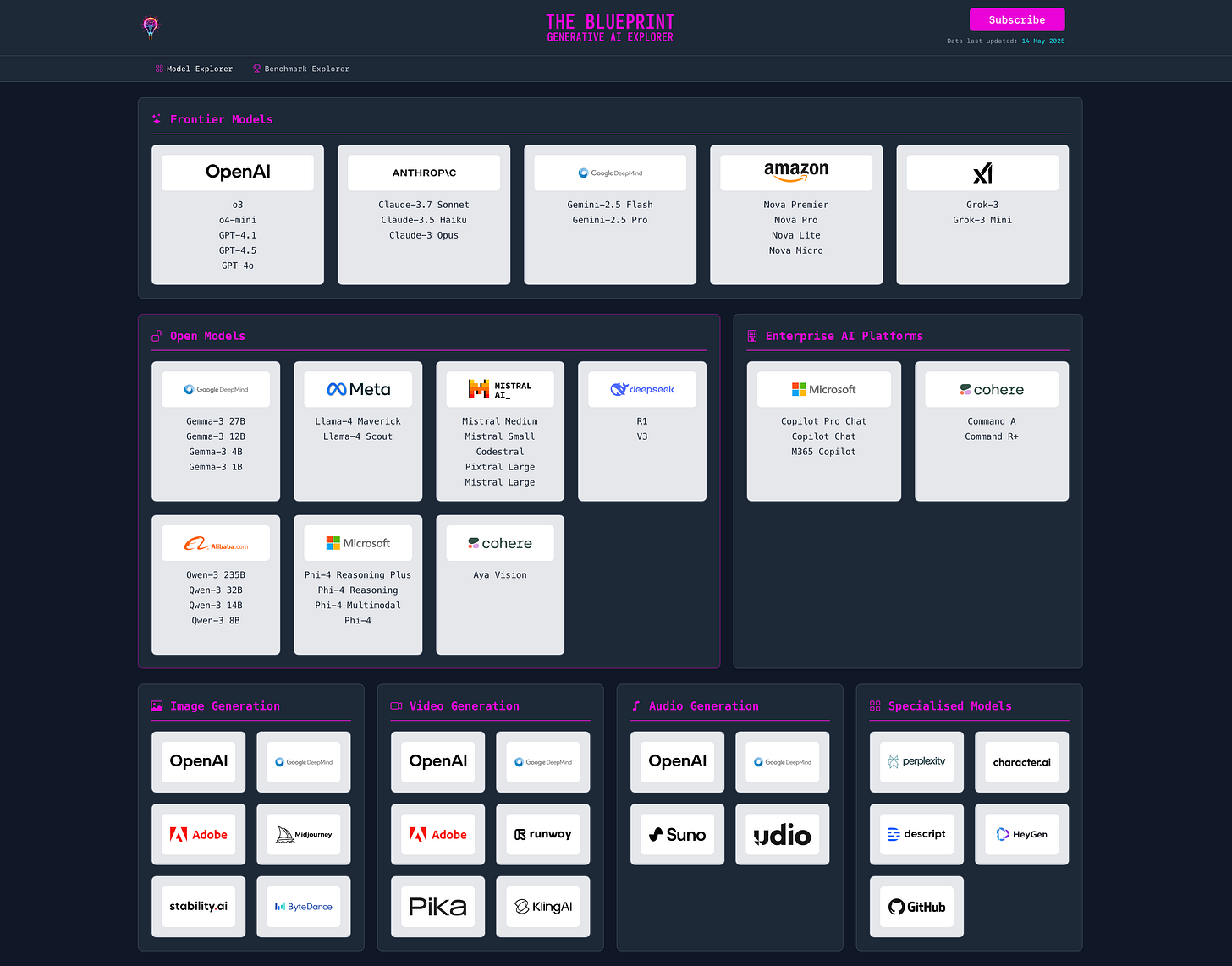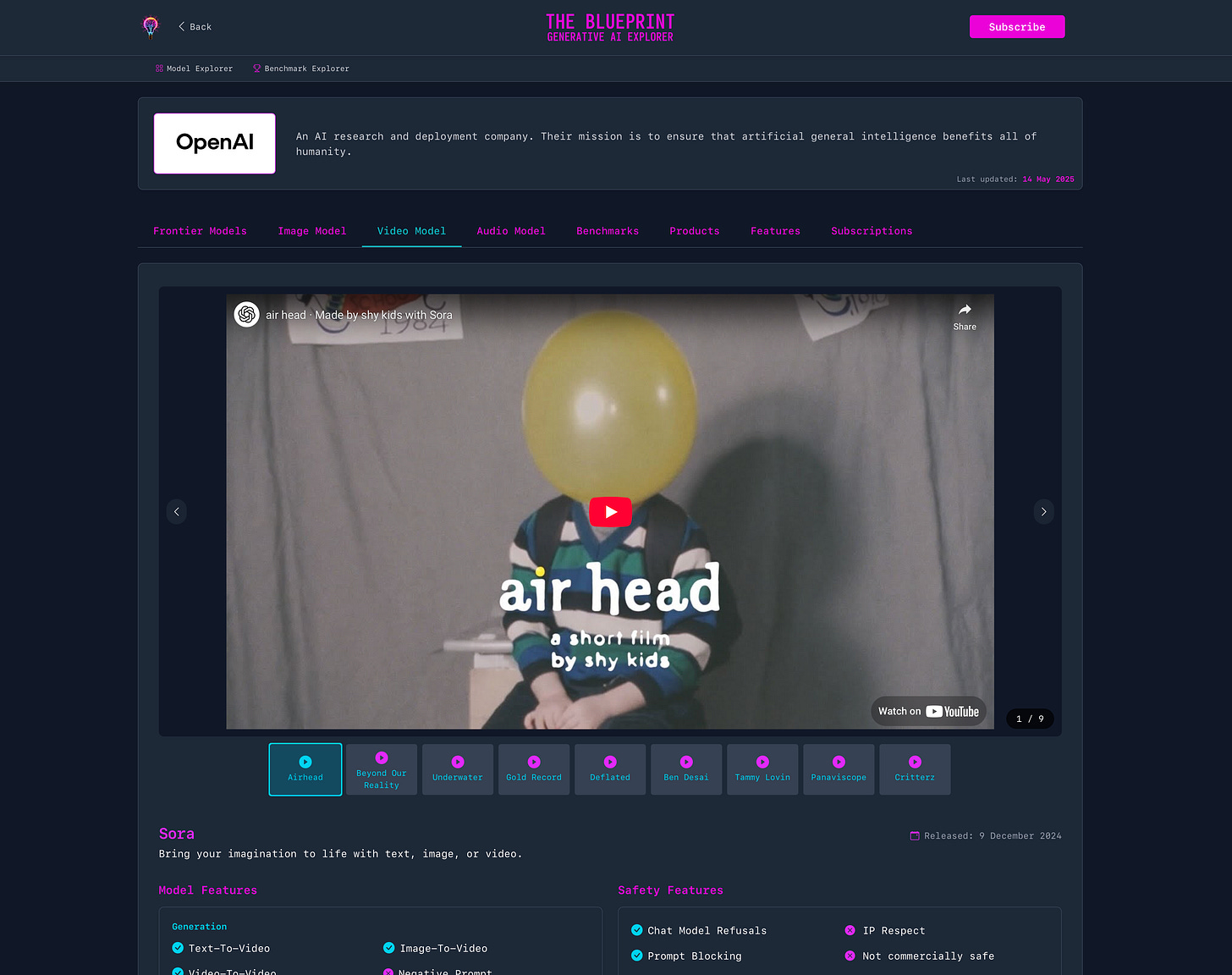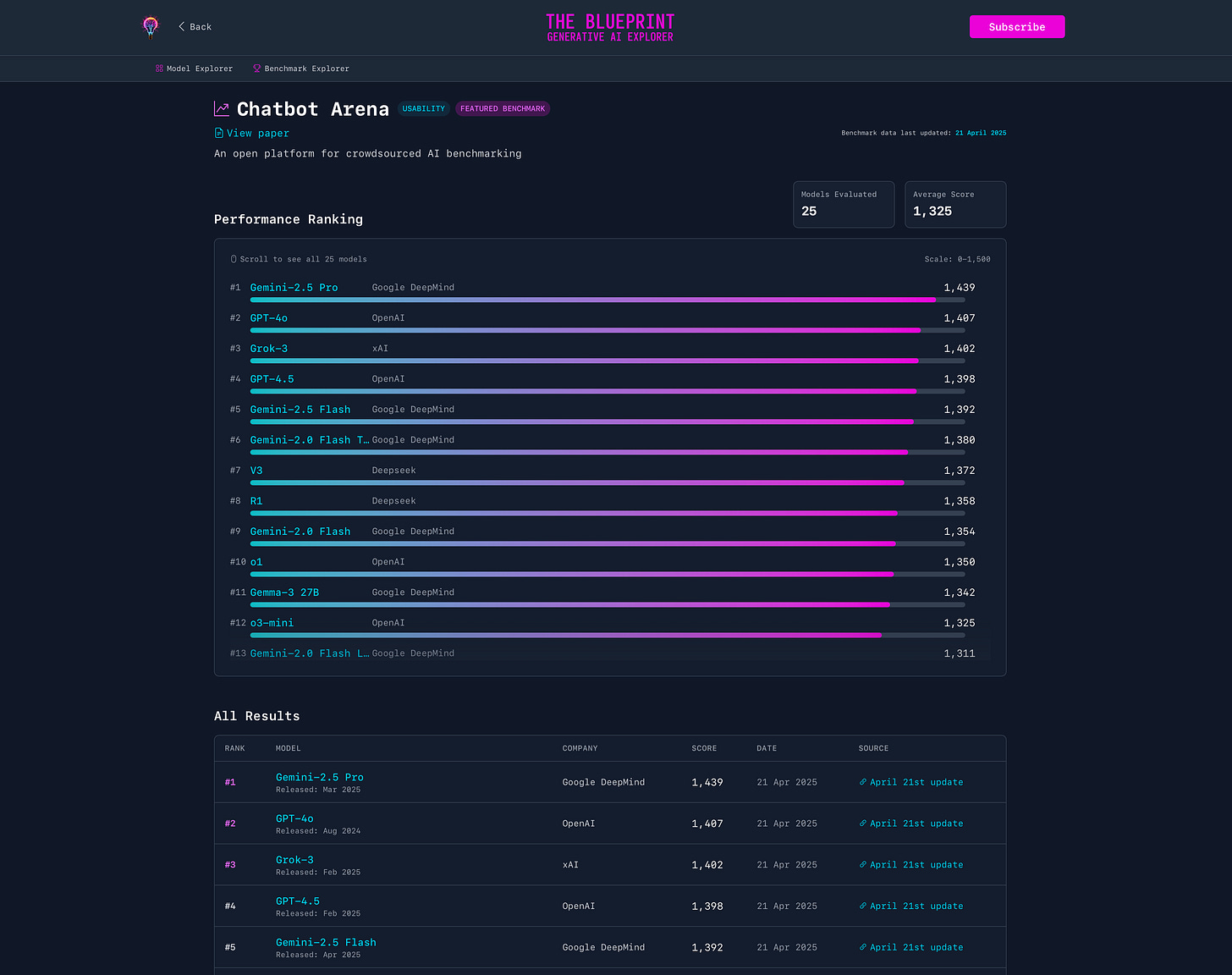Launching The Blueprint's Generative AI Explorer!
I'm adding a new feature to The Blueprint to help people explore the generative AI industry
I’m super excited to announce a bit of a passion project that I’ve been working on over the last month - The Blueprint’s Generative AI Explorer!
This new feature on The Blueprint is designed to help everyone get a better understanding of the Generative AI industry, the major companies involved, and their leading models. This should allow everyone to get a better understanding of where things stand with the technology, how the models compare to each other, and what the different types of models are.
You can access The Blueprint’s Generative AI Explorer using the link in the site’s navigation bar, as shown in the image above. Below I’ll run through all the different features I’ve built for in to the explorer.
Model Explorer
The main page of the Generative AI Explorer is the Model Explorer view. Here you can see all the leading generative AI companies and their major models. I’ve organised this into 7 different categories to help everyone navigate the different types of generative AI models that are widely available:
Frontier Models - these are the main state-of-the-art text-based models that are at the cutting edge of what’s possible within the closed ecosystem.
Open Models - these are the main open models that are at the cutting edge of what’s possible within the open ecosystem, as well as the main small models that can on device.
Enterprise Platforms - these are the main non-frontier models that large enterprises are using to help them get the most out of generative AI technology.
Image Generation - these are the main state-of-the-art image generation models that at the cutting edge of what’s currently possible
Video Generation - these are the main state-of-the-art video generation models that at the cutting edge of what’s currently possible
Audio Generation - these are the main state-of-the-art audio generation models that at the cutting edge of what’s currently possible. This includes both voice and music generating models.
Specialised Models - these are the most interesting, and mainstream specialised platforms that leverage generative AI technology for specific tasks.
If there are any big generative AI categories, companies, or models that you think I’m missing please let me know in the comments. I’m very open to suggestions to make The Blueprint’s Generative AI Explorer as useful and interesting as possible!
Frontier & Open Models
When you click on a company in the Model Explorer you will be take to that company’s page where you can a short description about them, and when I last updated their data.Below that you will see tabs that contain the details for each of the different types of models, benchmarks, products, features, and subscriptions that the company offers.
For companies with Frontier and/or Open models you will see a feature table for each of their main models. There are lots of details included about each of the models as well as links to resources for each of the models like the release post announcing the model, the model page (if available), system card (again, if available) etc. I’ve also included relative ratings for each of the models for Intelligence, Speed, and Reasoning. These are currently my own subjective scores, but I plan to calculate these from benchmark results in the future.
Image Models
For Image Models, there is a different view where you can see a showcase of example images generated by the model as well as information on when it was released, the features it has, and the aspect ratios it can generate. There are also technical details for any API endpoints that are available, demo videos for how to use them and links to additional resources and documentation.
Video Models
For Video Models I feature example videos generated by the model with a similar list of model features and aspect ratios as well as demo videos and links to additional resources and documentation.
Audio Models
The Audio Models tab has a similar layout to the Image and Video model tabs with example audio samples and model features. For Audio Models that give users specific control over voices I’ve also included specific features and languages that can be generated as well as the usual links to additional resources and documentation.
Products
The Products tab shows all the different generative AI products offered by a company. This includes all the major ones with an image, description and link to find out more about them.
Features
The Features tab shows all the different features that a company offers around its generative AI models. This is a comprehensive list of all the different things you can do with an image, description, and link to find out more.
Subscriptions
I’ve also included a subscriptions tab with pricing and details of each subscription tier for both consumer and enterprise subscriptions. I’ll try to keep these details as up-to-date as possible (they don’t change too often) and you can click on them to take you through to the subscription comparison page for each company.
Benchmarks
The Benchmark tab shows the benchmark scores across a wide range of benchmarks for the Frontier and Open models from a company. I’ve categorised these benchmarks into usability, agentic, coding, factuality, maths, multimodal, reasoning, and science benchmarks. This is an imperfect classification of all the different benchmarks that currently exist, but feels like a good starting point. I’m open to any suggestions or improvements! I’ve also created a Featured Benchmarks section at the top of the tab which highlights the most prominent and popular benchmarks that are used to grade generative AI models when they’re released.
The benchmarks scores are mostly sourced from the announcement posts of each of the major models over the last 18 months. Where multiple score for a single model are available for a benchmark I display the most recent score and you can see all the historical scores when you hover over it. You can also see any notes that go with the score and its rank vs. all other models in my benchmark database. When you click on the score you are taken directly to the source of the benchmark score. If you click on the benchmark name you will be taken to a page that shows you the scores for every model in my database for that benchmark (see below).
Benchmark Details
The Benchmark Details page shows you which category it falls in, a brief description of the benchmark, and when the data was last updated. There’s also a link to the research paper/website that’s home for the benchmark and the number of models evaluated by this benchmark in my database as well as the average score. You can then see the performance ranking of all the models and details of all the results I have in the database such as when the benchmark score was released and a link to the source for each benchmark score.
Benchmark Explorer
The Benchmark Explorer is the second main view in The Blueprint’s Generative AI Explorer. This gives people another entry point for exploring the different benchmarks that are currently widely used in the industry and includes their category, a brief description, the number of models in the database that are ranked against the benchmark, and the current leading model with its score. There’s also a link directly to the paper/website where you can find out more information about the benchmark. When you click on a benchmark you are taken to that benchmark’s details page, outlined above.
Similar to the Benchmarks tab, there is a section at the top for Featured Benchmarks that highlights the most prominent and popular benchmarks that are used to grade generative AI models when they’re released.
What’s Next?
There are quite a few improvements and features I want to build for The Blueprint’s Generative AI Explorer that I’ll be releasing over the coming months.
The first new feature will be a Model Comparer that will allow users to select up to four models that they’d like to compare to each other. This will allow everyone to compare features, pricing, and benchmarks for the models they select. I think this will be a really popular feature as it will allow everyone to quickly look at a variety of generative AI models to identify which one might be the best for their use case.
The second new feature that I’m thinking about is a chat interface so that users can interact with The Blueprint’s Generative AI Explorer like they interact with a large language model. I’m interested in exploring how we can evolve the basic chat interfaces we currently have and this will give me a good vehicle to do that. I also think it will be nice for users to be able to ask questions and more intuitively explore all the content and data available.
If there are any other features or ideas you have about how I could improve The Blueprint’s Generative AI Explorer, please do sound off in the comments. I’m really interested in any feedback or suggestions on how it could be improved and made more useful for everyone. Also let me know if there are any other categories, companies, models, or benchmarks that I should include. The site isn’t meant to be 100% comprehensive across the whole generative AI landscape, but I am open to adding new content and data if I think it’s useful and interesting to the majority of users.
As I said at the top, this has been a labour of love and hopefully something that people find useful. I’ve really enjoyed building this and I will be keeping the data update-to-date going forwards as new models and benchmarks are released. For full transparency, I built this with Claude Code. I wouldn’t say this site was ‘vibe coded’, but it also wasn’t coded ‘by hand’. It’s somewhere in-between, and not something I currently have the right label for!
“The future is already here, it’s just not evenly distributed.“
William Gibson















Very cool.